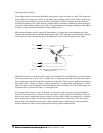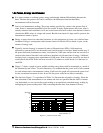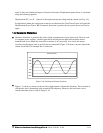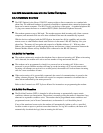
result, it does not include the impact of harmonic distortion. Displacement power factor is calculated
using the following equation:
Displacement PF = cos θ, where θ is the angle between the voltage and the current (see Fig. 1.9).
In applications where the voltage and current are not distorted, the Total Power Factor will equal the
Displacement Power Factor. But if harmonic distortion is present, the two power factors will not be
equal.
1.4:
Harmonic
Distortion
Q
Harmonic distortion is primarily the result of high concentrations of non-linear loads. Devices such
as computer power supplies, variable speed drives and fluorescent light ballasts make current
demands that do not match the sinusoidal waveform of AC electricity. As a result, the current
waveform feeding these loads is periodic but not sinusoidal. Figure 1.10 shows a normal, sinusoidal
current waveform. This example has no distortion.
Figure 1.10: Nondistorted Current Waveform
Q
Figure 1.11 shows a current waveform with a slight amount of harmonic distortion. The waveform is
still periodic and is fluctuating at the normal 60 Hz frequency. However, the waveform is not a
smooth sinusoidal form as seen in Figure 1.10.
Electro Industries/GaugeTech
Doc # E107706 V1.25 1-10
A Phase Current
-1500
-1000
-500
0
500
1000
1500
13365


















